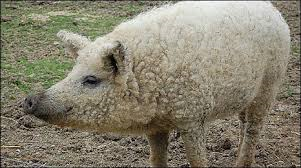Type the name of the breed you're looking for below
[wpdreams_ajaxsearchlite] Don't see the breed your're looking for? Click here and let us know!
Mangalica pig
| Place of Origin | Hungarian |
| Origin | The Mangalica (sometimes spelled Mangalitsa (UK) or Mangalitza (USA) is a Hungarian breed of domestic pig. It was developed in the mid-nineteenth century by cross breeding Hungarian breeds from Szalonta and Bakony with the Serbian Šumadija breed. The pig was originally bred for their lard in the 1830s by Austrian Archduke Joseph, Palatine of Hungary. After the collapse of the Austro-Hungarian empire the breed slowly disappeared, reaching a low point under Hungarian communism, where government policy combined with changing dietary habits brought it to near-extinction. The breed was revived in the early 1990s by a series of breeders, including the Hungarian Peter Toth. More recently, the pigs have been imported to the United States by a series of breeders, including Heath Putnam, Wilhelm W. Kohl, and Mosefund Farms. The blonde Mangalica was developed from older hardy types of Hungarian pig (Bakonyi and Szalontai) crossed with the European Wild Boar and a Serbian breed (and later others like Alföldi) in Austro - Hungary (1833). The development took place in Austro-Hungary (present day Arad county in Romania) in the early 19th century. The new quick-growing "fat-type" hog did not require any special care, and so became very popular in Hungary. In 1927 the National Society of Fat-Type Hog Breeders (Mangalicatenyésztők Országos Egyesülete) was established, with the objective of improving the breed. Mangalica was the most prominent swine breed in the region until 1950 (there were 30,000 of them in Hungary in 1943). Since then the popularity as well as the population of Mangalica have been decreasing, with the rising availability of food from farther away and refrigeration. Nowadays, the keeping of Mangalicas has become a popular hobby. There are currently slightly over 7,000 Mangalica sows in Hungary, producing around 60,000 piglets a year. In March 2006, 17 Mangalica were imported from Austria into the UK. These are registered with the British Pig Association (BPA) and the pedigrees are being maintained on the BPA Mangalitza Herd Book. Three of the animals are at Tropical Wings zoo in Essex. The Swallow-bellied Mangalica breed was produced by crossing the blonde Mangalica and the Black (which has gone extinct). |
| Purpose | Meat |
| Characteristics | The Mangalica pig grows a thick wooly coat similar to that of a sheep. The only other pig breed noted for having a long coat is the extinct Lincolnshire Curly Coat of England. There are three Mangalica breeds: Blonde, Swallow-bellied, and Red. They all have the same behavior; the only difference is the colour. The Blonde Mangalica is blonde, the Swallow-bellied (originally produced by crossing the Blonde Mangalica with the extinct Black Mangalica) has a blonde belly and feet with a black body, and the red (produced by crossing the Blonde Mangalica with the Szalonta breed) is ginger. Other breeds (black, wolf, and baris) have died out as pure-bred forms, though their reconstruction from selective breeding of mixed varieties is being debated in Hungary. |
| Other Considerations | Husbandry The Mangalica produces too little lean meat so it has been gradually replaced by modern domestic breeds. It is usually fed with a mix of wild pasture, supplemented with potatoes and pumpkins produced on the farm. The primary product made from this pig is sausage, usually packed in the pig's duodenum. The minced meat is seasoned with salt, pepper, sweet paprika, and other spices. It is then eaten in slices with pickled vegetables. The pork is also served braised with sauerkraut, potatoes, and stuffed peppers as a side dish. Farmers also produce smoked hams. The fresh meat tastes strong and juicy; the suckling pigs are much preferred for their good fresh meat qualities. In the UK, the breed is kept free-range, fed on standard Sow and Weaner Pellets. The higher quality and protein levels of this food results in a slightly larger stockier pig. In Hungary, most Mangalica pigs are raised semi-intensively or intensively. Mangalicas will happily rear their young (who are born striped like wild boars) in outside arks all year round without the need for additional heat and light. Killing weight (for meat production) is generally achieved beyond 12 months of age; much longer and the additional fat gained becomes too excessive for the UK market. Meat from Mangalica can be easily found in Hungary, as Hungarian farmers produce about 60,000 animals each year. |



